WANT EVEN MORE HEALTHY IDEAS FROM SHAPE YOUR FUTURE?
When you decide to start eating healthy, the first place you may look is the nutrition label. However, fumbling through the black-and-white text full of unfamiliar nutrients and confusing numbers may leave you feeling discouraged and confused. If you feel overwhelmed in the grocery store, these tips on how to read a nutritional label can help!
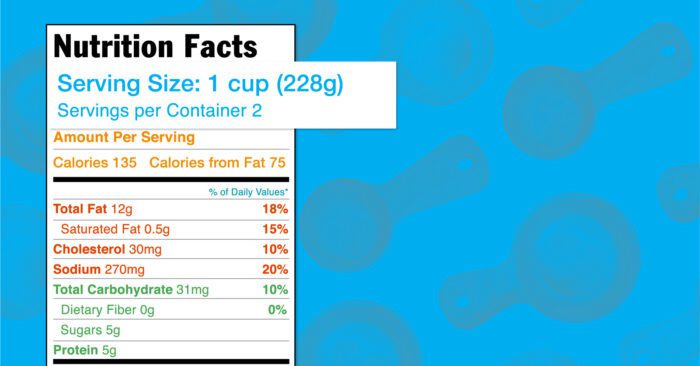
1. Start with the serving size
The serving size is the key that unlocks the rest of the nutrition label’s information. This line lets you know how much food you can dish out to make the rest of the label accurate, and it tells you how many servings are in the container to help you plan. The nutritional facts listed below are based on one serving size. So, if the package contains two servings, double the nutrition values.
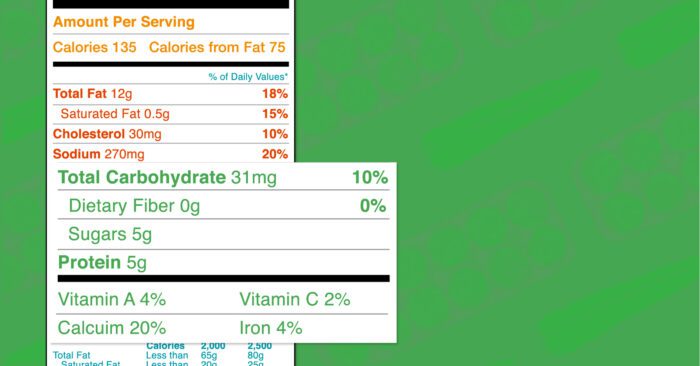
2. Know which nutrients fuel your body
As you shop, look for nutrients like protein, fiber, iron, vitamins and minerals. These nutrients provide nourishment and support that boost your immune system, help you break down foods and keep you full. These are the building blocks your body needs to thrive and stay healthy.
Here’s a list of a few common nutrients and how they positively impact your body:
- Calcium:Improves bone and teeth health. Look for it in dairy products.
- Fiber:Helps the body digest food and lowers cholesterol. Find it in most fruits, veggies and whole grains.
- Folate/folic acid:Helps form red blood cells and can contribute to a healthy pregnancy. Leafy, dark-green vegetables are a great source of folate and folic acid.
- Iron:Carries oxygen from the lungs to the rest of the body. Look for it in whole grains and proteins.
- Magnesium:Helps the body make protein, create energy and promotes healthy bones. Find magnesium in most fruits, veggies, whole grains and proteins.
- Omega-3 fatty acids:Helps reduce the risk of heart disease. Look to seafood for these nutrients.
- Phosphorus:Helps form strong bones and raises energy levels. Fruit, veggies and dairy are all generally high in phosphorus.
- Selenium:Strengthens the immune system. Find it in whole grains.
- B vitamins:Prevent blood clots and keep your nervous system healthy. Fruits, veggies and proteins are high in B vitamins.
- Vitamin A:Fights infections and strengthens your immune system. Orange and green veggies (like carrots!) are high in vitamin A. You can also find it in dairy and eggs.
- Vitamin C:Boosts your immune system. Look to citrus fruits for your daily dose.
- Vitamin D:Builds and maintains bones. Find it in most dairy products.
- Vitamin E: Protects your cells from harmful chemicals outside the body. Fruits, veggies and proteins are great sources.
- Zinc:Strengthens the immune system. Look to proteins for your daily zinc.
Check out our nutrition glossary for more information on vitamins, minerals and other common nutrients!
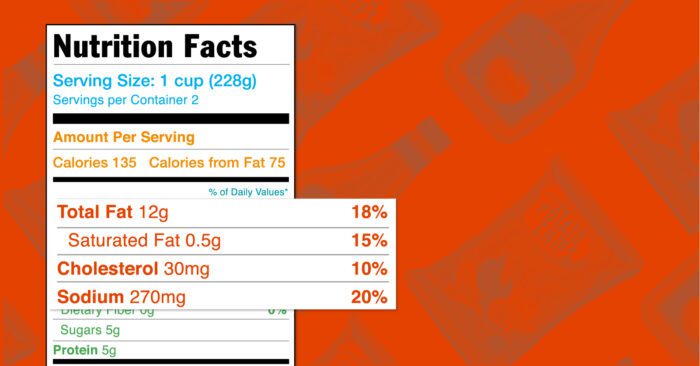
3. Know which nutrients slow you down
Keep an eye out for ingredients that negatively affect your health. High amounts of these can leave you feeling sluggish, impact your immune system and drain your energy.
- Saturated and trans fats:Lead to high cholesterol, which increases the risk of heart disease and stroke. Fatty beef, butter, cream and processed snacks can contain high amounts of both types of fat.
- Sodium:Results in high blood pressure and can lead to thirst and dehydration. Bacon, chips, microwaved snacks and canned goods can contain lots of sodium. Note: Some nutrition labels list “salt” instead.
- Sugar:Leads to insulin resistance, which increases the risk of Type 2 diabetes. Most people think of sugar in sweets, candy and soda. However, sugars like high fructose corn syrup and sucrose can hide in condiments and packaged foods.
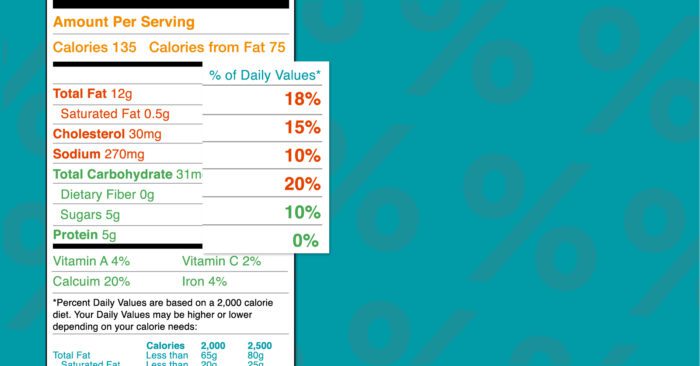
4. Reference the % daily value
Daily value percentages are usually printed along the right side of each nutrition label. The percentage is based on the amounts of nutrients recommended for Americans age four and older to eat every day. 5% or less is low, while 20% or more is high.
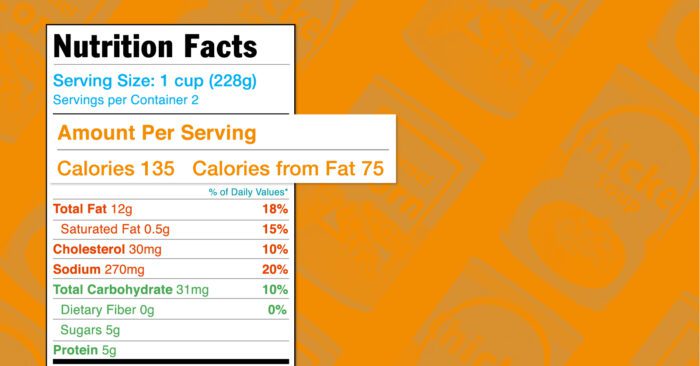
5. Check the calories
Your daily caloric intake will vary from person to person. However, it’s important to note where those calories come from. Calories made up of nutrient-rich vitamins and minerals will keep you feeling good throughout the day, while ones made up of mostly sugars or saturated fats may cause you to crash. Keep an eye out for foods high in calories and protein to balance your meals and keep you fuller for longer.
A quick tip: when checking the calories in your food, also check the serving size. Some packages contain multiple servings, meaning the calories can add up fast! For example, in the image above, there are 2 servings with 135 calories per serving. If you ate the whole package, that would add up to 270 calories, so make sure to read your labels!
Common Misconceptions and Label Red Flags
If you feel like you aren’t making progress toward your health goals, a good place to start could be to check the nutrition labels in your pantry. You might be surprised to find hidden sugars, saturated fats or additives in foods you thought were healthy. Companies often market their products as healthy when the opposite is true.
Look for these label red flags:
- Misleading “healthy” claims on the front of packaging
- Assuming “organic” = healthy or nutritional
- Skipping serving size and underestimating calories
In Oklahoma, 38.7% of adults and 17.9% of high schoolers are living with obesity. Read more about the impact obesity is having on our state here.
Practical Tips for Grocery Shopping and Meal Planning
Now that you know how to read a nutrition label, start applying these tips to your grocery store runs. When comparing two products, start by looking at the serving size, calories and daily value percentages for nutrients that matter most. Keep an eye out for foods that market themselves as “healthy” but are high in calories, added sugars or unhealthy fats.
When you start using nutritional labels as your guide, you’ll figure out how to grocery shop and meal plan more easily and better! Don’t forget — food safety and proper storage are just as important to your health journey as choosing the right foods. Get tips for food safety with our food safety cheat sheet.
With these tips to decode how to read a nutrition label in your toolbelt, the nutrition label will no longer feel like solving a puzzle. Approach your next trip to the grocery store with the ease of a seasoned shopper! If you’re looking for an easy guide to take with you, check out our nutrition label guide.





